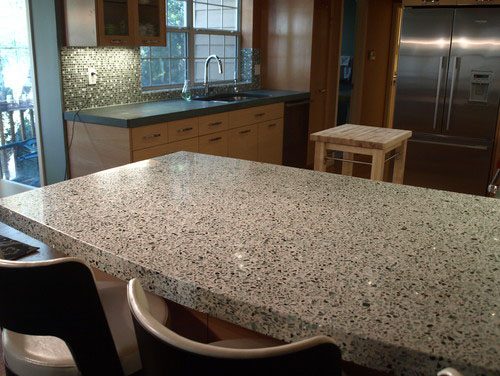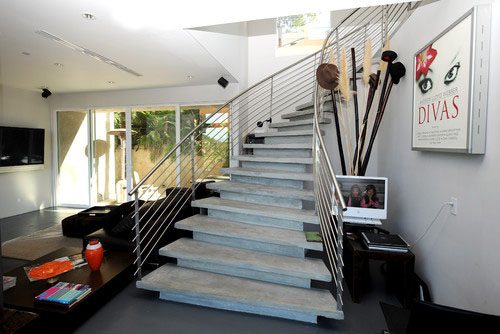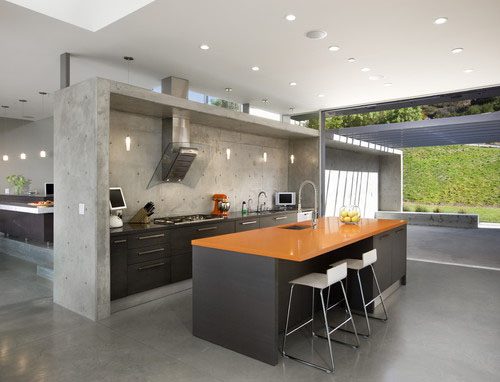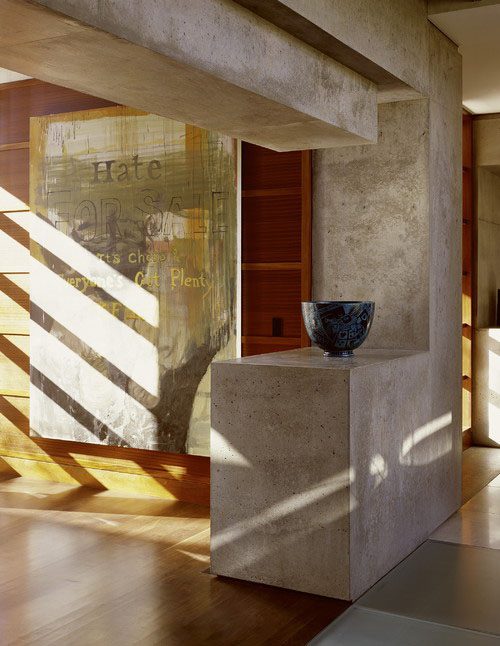Once an outdoor-only application, concrete has been permeating interior design with good reason.
The list concrete benefits is quite extensive.
- It’s easy to clean, extremely durable, and mimics more expensive materials wonderfully.
- Custom concrete can be poured in a precast mold, giving it limitless shape and design options.
- The weight and sturdiness of concrete make it an excellent structural element with a lot of trendy aesthetic qualities to boot.
The versatility of concrete designs make it a material that’s perfect in any room, with or without the cold, hard, industrial look of a basic concrete pour. Concrete solutions are becoming the creative answer to many interior and exterior home design dilemmas.

Colored concrete is used to tie this great room together through the countertops and fireplace surround. Dye can be added to concrete to give it some warmth and color. It can be textured like drywall to add depth and resistance to the surface. Concrete can be brushed, polished, or finished with a wax to give it different textures and a brighter sheen.

A countertop made from concrete and recycled glass mimics the high-end look of granite for a fraction of the price using more sustainable materials.
Concrete can be poured onsite in your home or it can be precast in a mold that’s designed specifically for your space. The latter takes a few weeks longer, but offers endless design options and custom concrete solutions.

The custom concrete vanity pictured here was creating by designing the sink right into the precast mold. The thick pour creates a high-end look for a low cost, whereas a similar look using a stone slab would be much pricier.
Concrete countertops have been appearing in more and more homes over the last decade, but concrete designs are suddenly being used in applications all over the home, including floors, whole walls, furniture, and other creative and decorative concrete solutions. It makes a lot of practical sense, especially when the modern, industrial look of concrete décor is all the rage.

A concrete staircase provides structure and a modern architectural element.
Concrete surfaces can also be stained after they’re poured to add color. Stained concrete has a mottled look that can’t be achieved through a premixed dye, as in this floor by RD Architecture. This kitchen includes wrapped concrete countertops that protect the cabinetry and provide an industrial aesthetic.
Concrete in the kitchen is nothing new, but some home bathrooms are going semi-industrial with concrete floors, walls, bathtub decks, vanities, and showers. It makes sense when concrete surfaces can be finished with different textures and sheens according to their intended uses.
This bathroom by Cottam Hargrave integrates a lot of concrete that extends into the outdoor shower. Not only the walls, floors, and countertops all concrete, but also the entire bathtub, creating an earthy look that sets the mood for a spa-like experience.
A concrete floor makes a lot of sense. It can be engineered to look like natural stone and poured to look like tiles or slab. It has the extreme durability demanded by high-traffic areas and options such as in-floor heat. When planning correctly, the look of a concrete floor can be striking.
Some homeowners shy away from the industrial look of concrete, but this floor by Elad Gonen and Zeev Beech shows how concrete can be stained and waxed to create a finish that’s warm and inviting.
This wall was poured against wooden boards to create the look and texture of a salvaged wood wall without sacrificing the black and white color scheme of the home. A waxed concrete floor provides contrast through opposing texture and sheen in this design by kbcdevelopments.
Concrete floors, walls, and ceilings give this bedroom by Pangaea Interior Design a modern, industrial look that’s softened by the colorful décor choices.

A modern look is created with plain concrete that’s industrialized by the holes. Warm, colorful tones in the home’s other design and decorating features offset the cold, hard look of the concrete.
Sometimes concrete can double as a structural element and design feature. This kitchen surround by Abramson Teiger Architects breaks up the home’s open floor plan and extends outdoors to the driveway and garage.
Concrete support beams and columns become a stylish art display in this room design by Ehrlich Architects.
Now that concrete is becoming so popular indoors and there’s a demand for the industrial look in home design elements, we’re seeing a resurgence in its use outdoors as well. Concrete is, of course, the perfect material to use outside for longevity, but it’s look used to be plain, simple, and boring. With the simple look making a comeback and aesthetically-based engineering becoming more commonplace, concrete is moving back outdoors with a vengeance.
Concrete was an exterior home design element before interior design began to demand its versatility and durability indoors. This traditional outdoor concrete and stone application by Case Design makes a great grill surround, sitting benches, planting boxes, and barrier wall for additional landscaping.

This outdoor concrete countertop is simple, modern, and functional. It provides a hard surface for cooking and entertaining, is easy to keep clean, and resistant to extreme weather conditions.
These raised concrete planting beds lend style and function to this yardscape by Jeffery Gordon Smith Landscape Architecture.
Concrete can work nearly anywhere around the home, indoors and out. Concrete has become so good at disguising its formerly plain self that you never know when and where you’re going to find it.

The concrete top of this dining table is enveloped by the room’s warm tones and softened by the dining chairs and area rug.
There are a limitless number of ways to use concrete around the home. Share your own unique concrete design applications with other Case Design readers below.








